Struve Geodetic Arc - meridian arc from Hammerfest in Norway to the Black Sea
As of 2022, the war in Ukraine makes it unsafe to travel around that country. Belarus is also in practice involved in the war with Russian troops on the ground. In addition, as Belarusian relations with Western governments have worsened considerably since the 2020 presidential election and flights between Belarus and the EU are suspended since the Ryanair Flight 4978 incident, for some nationalities it may not be a good idea to visit Belarus either.
Struve Geodetic Arc is a UNESCO World Heritage Site in Norway, Sweden, Finland, Russia, Estonia, Latvia, Lithuania, Belarus, Moldova and Ukraine.
Understand
The Struve Arc is a chain of survey triangulations stretching from Hammerfest in Norway to the Black Sea, through ten countries and over 2,820 km. These are points of a survey, carried out between 1816 and 1855 by the astronomer Friedrich Georg Wilhelm Struve, which represented the first accurate measuring of a long segment of a meridian. This helped establish the exact size and shape of our planet and marked an important step in the development of earth sciences and topographic mapping. It is an extraordinary example of scientific collaboration among scientists from different countries, and of collaboration between monarchs for a scientific cause. The original arc consisted of 258 main triangles with 265 main station points. The listed site includes 34 of the original station points, with different markings, i.e. a drilled hole in rock, an iron cross, cairns, or built obelisks.
Many of the inscribed sites are small posts in fields and may not reward a visit. However the focal point of the arc is the Dorpat Observatory in Tartu, Estonia.
History
The form and size of the Earth has been debated since the beginning of times. Nevertheless for a long time in history, the equipment and methods weren't adequate for exact measurements, leading to situations where Christopher Columbus would believe India would be "just around the corner" by sailing westwards from Spain, or Magellan barely surviving the trip across the Pacific which was several times bigger than he guessed.
Triangulation was invented in the 17th century as a new method of measurement of distances. A series of points were laid out in the landscape in a triangle configuration. The distance between two points needs to be measured. After that, from each point, angles were measured between all the other points that could be seen from that point using a theodolite. A theodolite is basically a telescope on a tripod with scales showing exactly in which position it's turned, and crosshairs and knobs to fine-tune its direction.
In those times it was known that the Earth wasn't a perfect sphere but there was a debate whether it was flattened on the poles or along the Equator. The circumference of the earth was defined as 360°, but exactly how long was one degree? Several expeditions were set out to measure the length of longitudal arcs, most notably to Lapland and Peru. The former expedition was led by the Frenchman Pierre Maupertuis in the 1730s, and Struve's measurements used the same lines one century later. The idea was to measure longitudinal arcs at different latitudes to form an idea about the shape of the Earth. Nevertheless the arcs were quite short compared to the Struve arc.
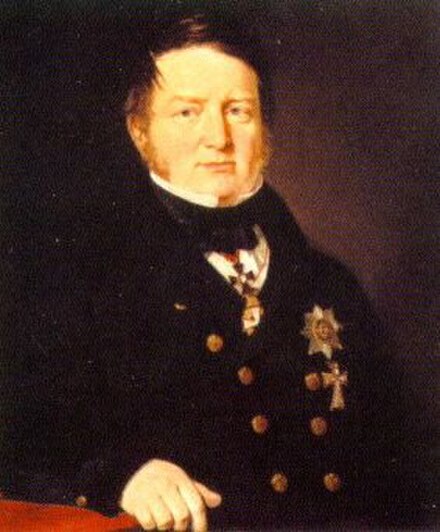
After the Napoleonic Wars, European kings and nations realized that more exact mapping and measurements was needed for success in future wars, more exactly, a framework or grid that maps could be drawn on. The German-born astronomer Friedrich Georg Wilhelm von Struve (1793–1864), working at the Dorpat University (the city's modern name is Tartu), and since 1812 in charge of trigonometrical surveying in Livonia (present-day borderland of Estonia and Latvia) proposed this project to the Russian Czar in 1819, and during the 1820s the first surveying was done between Gogland and Jekabpils (Jacobstadt back then). Dorpat university was chosen as the reference point of the arc, which fit together with recent triangulations around Vilnius by Carl Tenner (1783–1859) and Maupertuis' work in the Torne River Valley, which Struve was aware of and planned to incorporate.
The triangulation work headed by Struve would reach northwards to Gogland by 1831, and to Tornio by 1851, but he wouldn't be the only person heading the project. Tenner led the triangulation from Jekabpils to the Black Sea in three phases, 1816–28, 1835–40 and 1846–51. In the north, on Swedish-Norwegian soil, Nils Selander (1804–70) surveyed the part from Tornio to Kautokeino 1845–52 and Christopher Hansteen (1784–1872) from Kautokeino to Fuglenes 1845–50.
The results were published in 1860; in many countries the arc crossed, it would be the backbone of the survey systems for decades to come and one of the arcs used by British geodesist Alexander Clarke's computations concerning the Figure of the Earth 1858–1880. Considering the tools that were available at the time, the exactness was impressive. According to Struve's calculations the equatorial radius would be 6,378,360.7 m, whereas a modern-day measurement with satellite navigation yielded a radius of 6,378,138.8 m – a difference of about 224 m or 735 ft.
In 2005, after a research project spanning several years by authorities in 10 countries, UNESCO established the arc as a world heritage site. The physical remains of the survey, composed of holes drilled in rock almost 200 years ago, may not be much to look at, but the individual points often offer nice views over the landscapes and for some of them, impressive memorials have been erected. In addition, reaching many of the points is somewhat of an adventure still as of today, and if you visit many (let alone all) points, the vastness of the project performed in the age of horses and carts may come off as what's really fascinating about this set of locations across Northern and Eastern Europe.
Prepare
The most practical way to visit all the points on this itinerary is by car. It does not go through truly remote parts of the world, but especially in the north of the trip the distance between services may be long, and given the overall distance of the route you should make sure your car is in good condition. In addition, minor roads are sometimes in a poor shape, especially in the former Eastern Bloc.
If you decide to travel the journey by public transport, you are likely in for long hikes, hitchhiking or taxi journeys for the remotest points even if they happen to be next to a road, alternatively you can skip those. Traveling the entire journey by bike or foot is at least theoretically possible if you have the time and stamina. Instructions for getting between the points by public transportation are written in italics below. The information is based on Internet research as of March 2021; useful websites for up to date schedules and available routes can be found on this article's talk page or in the get around sections of articles of countries and cities the itinerary goes through.
Even if you travel in a comfortable way between the points, be aware that some of the points require some effort to get to; for example Tornikallio in southern Finland entails an uphill hike from the parking lot with the path leading across rocks and tree roots and can't exactly be described as accessible if you're physically or visually disabled.
Get in
The points of the arc run over 2,820 km. from above the Arctic Circle to the Black Sea, making it one of the longest inscription on the World Heritage List . Due to the vast distances there are very many ways to get to see it.
In addition to being spread over a large area, many of the components of this world heritage site are outside major cities and towns. A car is probably your best bet if you want to visit as many points as possible within a reasonable timeframe. The points located in the Gulf of Finland will still be problematic to access.
Norway, Sweden, Finland, Estonia, Latvia and Lithuania are members of the Schengen Area while Belarus, Moldova and Ukraine are not, meaning they have separate visa regimes. Most EU nationals enjoy relatively hassle-free access to the non Schengen countries on this itinerary, but you should still take your passport. Belarus had a notoriously "closed" visa policy in the past but has since greatly relaxed its rules for EU citizens. The Russian part of the Struve Arc on the island of Gogland is not accessible for tourists, so one has to skip this part and travel from Finland straight to Estonia (or vice versa). For more details see individual country articles.
Go
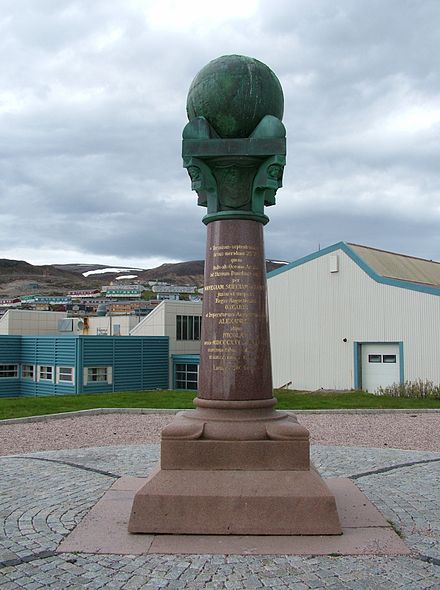
Norway
The northern end is about as far north as you can get in Europe. To get here, you can follow the E6 through Sweden and Norway to Skaidi. Alternative routes for parts of the journey are E45, E4 or E8 all depending on where you come from, though you will drive along the latter on your journey south. From Skaidi, Highway 94 takes you up to Hammerfest.
Far from most of everything, you may want to fly in; Tromsø is the main hub of the region and from there you can fly to Hammerfest. Hammerfest airport is a little more than a kilometer of walking from Fuglenes. Hurtigruten also calls at Hammerfest, it's about 2.5 km around the bay to Fuglenes from the harbour.
- [Fuglenes, Hammerfest, Finnmark](https://struve.no/engelsk/stedene/the-endpoint-in-hammerfest/)[ 📍](https://www.google.com/maps?ll=70.67,23.663333&q=70.67,23.663333&hl=en&t=m&z=11) – Fuglenes, "Bird's peninsula" is in the Fuglenes district of Hammerfest on a hill with a view to the Arctic Sea. The point is marked by a green globe standing on a granite pedestal, this monument is called Meridianstøtten. Backtrack to Skaidi, and drive southwest along the E6 to Alta. Before crossing Alta River, turn left to a smaller road to Kaiskuru and continue to Raipas.
Compared to the rest of the itinerary, you're spoiled by choice to get to Alta; you can pick between bus, boat or plane. Once in Alta it's time to put on your walking shoes, namely there are no public transport to the parking refered to below. The harbour, airport and closest bus stop are to the east of the city - if you go by bus don't go all the way to Alta downtown, but get off at the Storeng stop at the E6 before the bus crosses Altaelva. From the airport and harbour, walk back along the E6 and across that river. From the E6, a road named Kjosveien leads up to Raipas, there's 3.5 km to the trailhead.
- [Raipas, Alta, Finnmark](https://struve.no/engelsk/stedene/lille-raipas-alta/)[ 📍](https://www.google.com/maps?ll=69.938611,23.360278&q=69.938611,23.360278&hl=en&t=m&z=11) – The Raipas point is not far from Alta as the crow flies, but the road there goes on the other side of Altaelva (Alta River) to the settlement of Raipas. Next to the road there's a parking, from where you will hike uphill for a couple of kilometers to the summit of Lille Raipas around 250 m ASL. Alta also has another World Heritage site, the Prehistoric Rock Carvings just west of town along the E6.
From Alta, take E45 south towards Kautokeino.
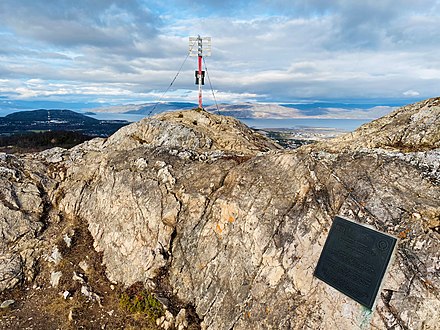 Get back down to the E6, from where you probably could get a bus into central Alta from where you could get on a bus towards Kautokeino if you plan to visit the other two points in Norway. Be aware that they each entail quite a bit of hiking, plus there may be no bus further into Finland so you will have to travel back to Alta by bus, or possibly hike or hitchhike for 80 km down to Enontekiö. To get to the following point, get off at Suolovuopmi fjellstue (Suolovuopmi lodge), from where it's about 10 km along a gravel road, and a further 3 km to the point as per below. Return to the lodge - unless you carry a tent, this would be the place to sleep around here...
Get back down to the E6, from where you probably could get a bus into central Alta from where you could get on a bus towards Kautokeino if you plan to visit the other two points in Norway. Be aware that they each entail quite a bit of hiking, plus there may be no bus further into Finland so you will have to travel back to Alta by bus, or possibly hike or hitchhike for 80 km down to Enontekiö. To get to the following point, get off at Suolovuopmi fjellstue (Suolovuopmi lodge), from where it's about 10 km along a gravel road, and a further 3 km to the point as per below. Return to the lodge - unless you carry a tent, this would be the place to sleep around here... - [Luvdiidčohkka, Kautokeino, Finnmark](https://struve.no/engelsk/stedene/luvddiidcohkka-lodiken-eng/)[ 📍](https://www.google.com/maps?ll=69.664444,23.602222&q=69.664444,23.602222&hl=en&t=m&z=11) – One of the more challenging points to visit (as are the next few ones), on the summit of Luvdiidčohkka (also known as Lohdizhjokki or Lodiken) 638 m ASL. From the E45, there's a gravel road going north, which may be too rough for normal cars. From the closest point on that gravel road (there's a red cabin on the right-hand side of the road) there's a hike of about 3 km along a path to the summit.
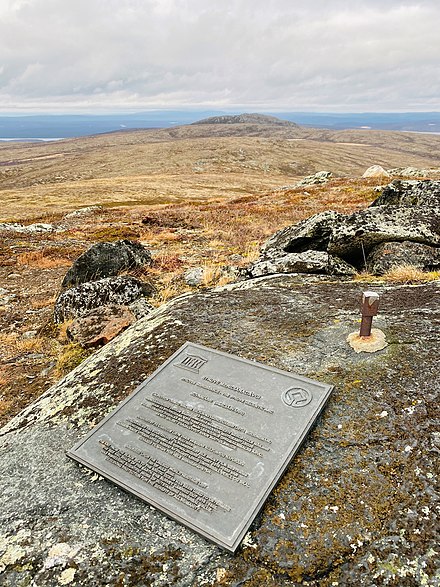 Continue by bus to Kautokeino. From the south of the town, the road forks off to Avzi as per below. It's about 11 km to Avzi from Kautokeino and a further 5 km of hiking to the point.
Continue by bus to Kautokeino. From the south of the town, the road forks off to Avzi as per below. It's about 11 km to Avzi from Kautokeino and a further 5 km of hiking to the point. - [Bealjášvárri Kautokeino, Finnmark](https://struve.no/engelsk/stedene/page-41/)[ 📍](https://www.google.com/maps?ll=69.028611,23.305278&q=69.028611,23.305278&hl=en&t=m&z=11) – From the town of Kautokeino, a smaller road goes east to the village of Ávži. From there, a path or rather gravel road marked as a snowmobile trail forks off the main road. Baelljasvárri is 585m ASL, and there are again a few kilometers of hiking to get to the point. Continue along the E45 into Finland.
To skip a couple of points ahead after having visited Raipas or to continue from Alta after the above points, there doesn't seem to be any buses westwards from Alta, so head to the airport, fly to Tromsø and take a Finnish bus towards Rovaniemi. It will go back to Skibotn, and continue southeast along the E8 and into Finland.
Should there be no bus into Finland you're in for hitchhiking, a very long walk or a series of flights. The latter means flying from Alta to Oslo, and from there either to Helsinki and on to Kittilä or to Stockholm and on to Kiruna or via Luleå to Pajala.
Sweden and Finland along the border
The Tarvantovaara wilderness area can be entered from near the border between Kautokeino and Enontekiö (entering from the eastern side) or from near Karesuvanto (entering from the southwestern side). If coming in from the direction of Skibotn, the bus will stop at Karesuvanto. This is also where to get off the bus if you plan to visit the following couple of points in Sweden. Alternatively you could continue by bus all the way to Rovaniemi to skip down to the Aavasaksa or Tornio point.
If you've ended up in Enontekiö centre (Hetta), you can take a bus towards Kilpisjärvi to get to Karesuvanto, alternatively head down to Rovaniemi.
- Stuorrahanoaivi, Tarvantovaara Wilderness Area 📍 north of Karesuvanto, in Enontekiö, Finnish Lapland – By far the most remote of the points, in the middle of Tarvantovaara Wilderness Area, about 30 km from Karesuvanto and from the hamlet of Palojärvi on the Kautokeino–Hetta highway. While getting to and back from other "remote" points listed here generally takes a couple of hours, in this case the question is about a couple of days. This trek of a mere 60 km could in your imagination be extended to the more than tenfold distance the expeditions trekked, without the comfort of modern hiking equipment. There are open wilderness huts halfway, but you probably want to sleep in a tent near the peak not to have too long a second day. There are footpaths most of the way, although none of them marked. You should have enough hiking experience and good enough equipment to get along if you loose the way at some point, or if weather deteriorates. See Stuorrahanoaivi trek for suggested routes and more detailed advice.
The E45, also numbered as Finnish Highway 93, continues south to the town of Hetta, west to Palojoensuu, then jointly with Highway 8 and E8 northwest to the Karesuvanto/Karesuando crossing. After entering Sweden, drive south along Swedish Highway 99. The next few points will be near this road.
From Karesuvanto, cross the bridge to the twin town, spelled the Swedish way. As there are no buses southwards along the river on the Swedish side, Tynnyrilaki is challenging to visit car-free. The end of the gravel road mentioned below is more than 30 km south of Karesuando.
- ["Pajtas-vaara": Tynnyrilaki, Kiruna Municipality, Norrbottens län](https://www.lansstyrelsen.se/norrbotten/besoksmal/varldsarv/struves-meridianbage/tynnyrilaki-kiruna-kommun.html)[ 📍](https://www.google.com/maps?ll=68.255002,22.9808669&q=68.255002,22.9808669&hl=en&t=m&z=11) - On the Swedish side of the border; you can cross the border in Karesuvanto/Karesuando or Muonio and travel along Swedish highway 99 following the border. At the southeastern end of lake Paittasjärvi (there's a hamlet by the same name at its western shore) a narrow unmarked unpaved road goes to the north along the eastern shore of the lake – it might be possible to drive along it. After about 3-4 km turn there's a junction where you should turn right, some 1.5 km later there's a smaller path to the right leading to Pajtasvaara hill (445 m ASL), also known as Tynnyrilaki. Tynnyrilaki means "barrel top" in Finnish and the name comes from the fact that Struve's team raised a rod at the measuring points with a barrel at the end, and this setup was visible from the next measuring points.
Whereas there are no buses along the river, there are buses from Karesuando towards Kiruna. Travel as far as Vittangi, and take another bus to Pajala. Get off before the town, at the junction with the highway 99 coming in from Karesuando. Jupukka hill is about 3 km north along highway 99.
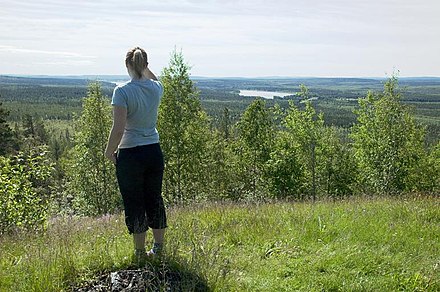
- "Kerrojupukka": Jupukka, Pajala, Norrbottens län 📍 - Follow the same highway south, and a little before Pajala, it will pass near the Jupukka, a hill with an altitude of 277 m ASL, and the middle point of Jupukka Nature reserve. There's a signposted smaller road off the highway to a parking area from where there is a steep path up to the summit.
Hike back to the junction, or to Pajala which is a further 5 km or so southwards. From Pajala there are four buses on workdays towards Haparanda at the Bay of Bothnia, which is near the end of this set of points. The ski lifts to the Pullinki point are about 3 km from the village of Svanstein next to the highway.
- ["Pullinki": Pullinki, Övertorneå, Norrbottens län](https://www.lansstyrelsen.se/norrbotten/besoksmal/varldsarv/struves-meridianbage/pullinki-overtornea-kommun.html)[ 📍](https://www.google.com/maps?ll=66.646391,23.7797557&q=66.646391,23.7797557&hl=en&t=m&z=11) - This point, and the ones that follow, is a bit accessible. The Pullinki hill (335 m ASL) serves as a ski resort, and there's a ski lift to the summit (likely just operating during the ski season) in addition to a path going from the main building of the ski resort to the summit. As this is a ski resort, the forest has been cut down and there are good views towards the Torne River valley and Finland, including to Aavasaksa. Pullinki and some of Struve's points further south in the river valley were used for similar measurements already in the 1730s by the French scientist Pierre Louis Maupertuis who proved that the Earth isn't a perfect sphere. From Övertorneå, cross back into Finland, past E8 towards Rovaniemi for a few kilometers, then turn left (signs say Aavasaksanvaara).
Further south with the Swedish bus, get off at Övertorneå bus station, walk across the bridge to the Aavasaksa village of Ylitornio, Finland. It's about 2.5 km to where you cross Highway 8, another 2.5 km eastwards towards Rovaniemi to the junction from where a road goes up to Aavasaksa and yet another 2.5 km to the summit. If you've skipped the Swedish points and started from Rovaniemi, there's a direct bus to Aavasaksa village and you can get off at said junction.
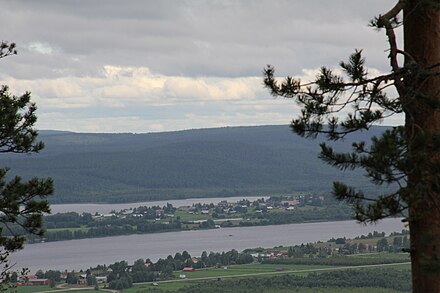
- Aavasaksa, Ylitornio, Finnish Lapland 📍 - Aavasaksa in Finland, right across from Övertorneå/Ylitornio border bridge has been a tourist resort for almost a century and a half. In 1881 when Finland was a Russian province, the Russian emperor Alexander II planned a visit and a big log cottage (Keisarinmaja) was built for him at the summit (the trip never happened as he was assassinated) and today it's one of Aavasaksa's attractions. You can also find a memorial to Maupertuis' expedition here, and an observation tower built of bricks with the Struve plaque on its side. Aavasaksa is one of the national landscapes of Finland, and there's a drivable road all the way to the summit (242 m ASL). Backtrack into Sweden and continue south along Highway 99.
To visit the Perävaara point, backtrack to Övertorneå bus station and take a bus going southwards until Karungi. As you're walking, you may be able to get to the point from the village of Karungi instead of having to go around the whole forest as in the listing description. As the crow flies, the distance from Karungi is 4 km and the Right to access in the Nordic countries applies, nevertheless navigation may be a problem as there is likely no marked path from there.
To skip Perävaara and save some walking, there are direct buses from Aavasaksa to Tornio, or you could travel via Rovaniemi.
- ["Perra-vaara": Perävaara, Haparanda, Norrbottens län](https://www.lansstyrelsen.se/norrbotten/besoksmal/varldsarv/struves-meridianbage/peravaara-haparanda-kommun.html)[ 📍](https://www.google.com/maps?ll=66.0180578,23.9203113&q=66.0180578,23.9203113&hl=en&t=m&z=11) - Perävaara is on the Swedish side, further downstream Torne River. The terrain becomes flatter closer to the sea, and at just 89 m ASL Perävaara still rises above its surroundings. It's in the middle of the woods, near the village of Karunki and the only point in Sweden with the original markings preserved. There are many paths in the forest, but the regional administration of Norrbotten suggests to drive along Highway 99 about 10 km south from Karunki, then along local road 730 (such roads are all too often not numbered in Sweden) towards Björkfors for 1 km, then head north along a forest road for 1 km to a designated parking lot and walk along a forest road from there for 5 km to a path leading up to the summit. Back on the main highway, continue south to Haparanda, cross over into Tornio, Finland. Drive towards Kemi, and you will pass under a railway bridge. In the next crossing, turn right and drive south along Röyttäntie. After crossing a branch of the river, turn right at the next road and you will soon see the church at the left side of the road.
Take the bus from Karungi to Haparanda (or per above, from Aavasaksa), it will stop at the Tornio-Haparanda bus station. Theoretically, from here by far the shortest way to the next point would be down the river and across the railway bridge to the Finnish side landing you almost next to the church. The bridge used for occasional freight traffic but while the risk of you encountering a train there is low it's almost certainly illegal (even as people can cross freely between the countries). As such you need to walk into Tornio from the station, cross the main branch of the Tornio river on the pedestrian bridge, walk downstream to Länsipohjankatu, cross under the railway, follow Röyttäntie south and over the bridge across the river branch. Turn right onto Parasniementie, pass under the railway and the church is soon on your left-hand side. This hike is about 4 km. Alternatively, Tornio does have a form of public transportation, a minibus circulating the city a few times daily on weekdays, that can take you from the bus station to the Röyttäntie/Parasniementie crossing.
- [Alatornion kirkko, Tornio, Finnish Lapland](https://www.tornionseurakunta.fi/kirkot-ja-tilat/kirkot/alatornion-kirkko/alatornio-church)[ 📍](https://www.google.com/maps?ll=65.83,24.157222&q=65.83,24.157222&hl=en&t=m&z=11) - Alatornio church is one of the easier points to access. There have been several churches standing on this place at least since 1316, possibly even earlier. The tower of the present-day church (finished in 1797) was used as triangulation tower by Struve's team, the earlier church tower, in turn by Maupertuis. To get to the next point, backtrack to the main highway, drive to Kemi, and continue along Highway 4 to Jyväskylä, then towards Tampere.
Pedestrians can head back to Röyttäntie and follow it north almost to Highway 29 - to Putaankatu street (about 2 km). Right at the junction there's a bus stop where you can take a bus to Kemi or to Kemi-Tornio airport (if you want to fly to Helsinki to skip the Finnish points or even fly on to Tartu). From Kemi, continue by bus to Oulu, on to Jyväskylä and on towards Jämsä to get to the Oravivuori point, alternatively board a train down to Helsinki to skip the Finnish points but still travel overland.
Central and Southern Finland
Buses travel along Highway 9. About 35 km from Jyväskylä, get off the bus at the Puolakka road junction, and walk for 9 km to get to Oravivuori.
- [Oravivuori, Korpilahti, Central Finland](https://visitjyvaskyla.fi/en/attractions/oravivuori-nature-trail-and-triangulation-tower/?theme=orange)[ 📍](https://www.google.com/maps?ll=61.926667,25.533611&q=61.926667,25.533611&hl=en&t=m&z=11) — From the Jyväskylä–Jämsä road 9 E63, turn off towards Puolakka if coming from Jyväskylä, or Saalahti if coming from Tampere, these are the ends of the same road. Follow it for around 10 km until you see signs to the Struve chain to the parking lot to the right. From there it's 1 km of hiking uphill. The view to lake Päijänne from the tower is nice, though at the point where the UNESCO marker is, the view is obstructed by pines. Oravivuori is 193 m ASL.
Drive back to the main road, continue to Jämsä and Lahti and Highway 4 past Lahti. At the southern junction of Lahti, take road 167 to Orimattila and Myrskylä, road 174 for a short bit towards Artjärvi, then road 1751 towards Porlammi.
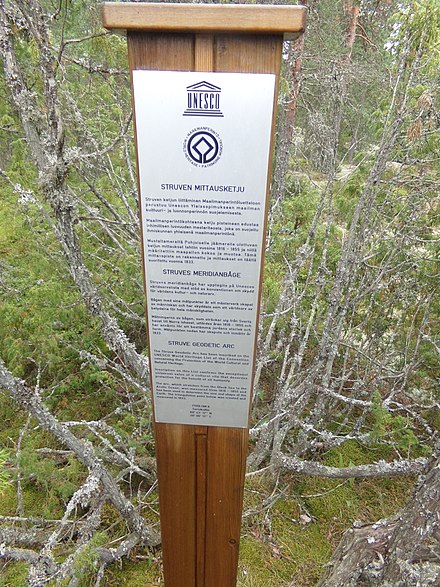 From Oravivuori, head back the same way to the highway and get on a bus to Jämsä, Lahti or even all the way to Helsinki. Once in Helsinki, take another bus towards Kouvola and get off just before Lapinjärvi. It's a walk of about 14 km, first to Porlammi, then towards Myrskylä and along a small road to Tornikallio. There are bus stops along the country roads but apparently no services.
From Oravivuori, head back the same way to the highway and get on a bus to Jämsä, Lahti or even all the way to Helsinki. Once in Helsinki, take another bus towards Kouvola and get off just before Lapinjärvi. It's a walk of about 14 km, first to Porlammi, then towards Myrskylä and along a small road to Tornikallio. There are bus stops along the country roads but apparently no services. - [Tornikallio, Lapinjärvi, Uusimaa](http://www.visitlapinjarvi.com/nature-attractions.html)[ 📍](https://www.google.com/maps?ll=60.704722,26.003333&q=60.704722,26.003333&hl=en&t=m&z=11) — From the Porlammi–Myrskylä road follow the signs to the parking lot, then it's first 200 m backtracking along the road and about 400 m of hiking uphill; probably not a good idea in the winter. There are nice views over Lake Pyhäjärvi, although at the point where the UNESCO marker is, it is mostly obstructed by pines. Tornikallio is 98 m ASL. Continue via Porlammi to Lapinjärvi and Highway 6. The next points are difficult and very difficult to get to. To skip them and get to the Estonian points, head to Helsinki for the ferry. Otherwise, road 167 from central Lapinjärvi goes down to Lovisa. Lovisa or Pyhtää/Pyttis may be points to start if you can arrange for a boat to Mustaviiri. The other option is to get close to it on land, in that case drive through the city (or stop for sightseeing), and when you see the Ungern bastion on the left, turn right to Hästholmen, and follow the road to its end, the hamlet of Söderby. The island is less than 10 km south-southeast.
From Tornikallio, there's the same walk back to Highway 6 and Lapinjärvi. From here you have several options. Head back to Helsinki for the Estonian points, or with that same bus to Vanhakylä (Gammelby), cross below the motorway and take another bus towards Lovisa and Kotka. To get to the same viewpoint, get off the bus after passing Lovisa. There's about 23 km along the country road to Söderby. If you rather skip that but would like to go to Kotka to see Gogland (or on to Russia), stay on the bus. Alternatively you can take the bus from Lapinjärvi to Kouvola instead, and a train down to Kotka.
- [Mustaviiri, Pyhtää, Kymenlaakso](https://www.nationalparks.fi/gulfoffinlandnp/history)[ 📍](https://www.google.com/maps?ll=60.276389,26.603333&q=60.276389,26.603333&hl=en&t=m&z=11) — Located in the Gulf of Finland, you will need a boat to get to this point.
Russia
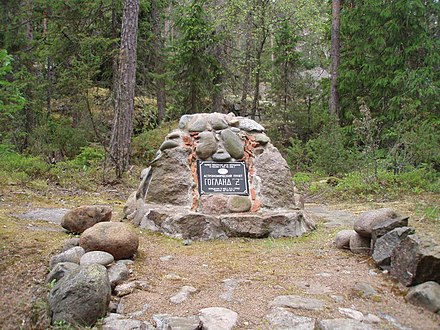 Since Russian authorities declared Gogland Island a "border area", it is not allowed for foreign nationals to travel to the island without special permits. This limits tourism from abroad to small groups admitted one at a time. There are two Struve Geodetic Arc points on Gogland:
"Hogland, Z" 📍 and "Mäki-päälys" 📍.
Since Russian authorities declared Gogland Island a "border area", it is not allowed for foreign nationals to travel to the island without special permits. This limits tourism from abroad to small groups admitted one at a time. There are two Struve Geodetic Arc points on Gogland:
"Hogland, Z" 📍 and "Mäki-päälys" 📍.
In the case you've managed to get on a tour to Gogland, your trip is likely to start in Russia, so head east. Nevertheless, the island is in a sense not that remote even if it's 40 km off the coast. Gogland is called Suursaari - "Big Island" - in Finnish and it's a pretty large thing in the middle of the Gulf of Finland; 11 km north to south and 3 km wide at its widest point, with several hills above 100 m and the highest point 173 m above sea level. As such it's visible from certain places on the coast (providing there are no other islands in the way), or from Haukkavuori observation tower in Kotka.
To get to the Estonian points, head towards Helsinki and the Tallinn ferry. If you have gotten the permits to visit Gogland, and will start that trip in Russia, the buses from Helsinki to Saint Petersburg often stop in Kotka. Or you can take the train up to Kouvola where the train line to Russia goes and catch a train east from there.
Estonia
To get from Finland to Estonia, you can make use of the frequent ferries that cross from Helsinki to Tallinn. These ferries are rather popular with Finns going south for fun and Estonians going north for work.
From Tallinn, drive east on Highway 1 (E20) for about 100 km to Rakvere, along the city's ring road, from the southwest of the city Highway 22 to Väike-Maarja and past the town to Ebavere. Then turn towards Simuna along road 109. If you've visited Gogland from Russia you can take E20 to the Estonian border at Ivangorod/Narva, on to Rakvere and continue as above.
Off the ferry in Tallinn, head to Balti Jaam - Tallinn's railway station - and board the train to Tartu. Get off at either Rakke or Tamsalu from where there are local buses taking different routes that can take you to Simuna or even to Võivere (in other cases, walk there from Simuna, it's about 4 km northwest). The next point is just east of the village.
Coming from Russia, take the Saint Petersburg-Tallinn train to Rakvere, and one of similar local buses from there to get to Simuna.
- ["Woibifer": Võivere, Avanduse, Lääne-Viru](https://www.visitestonia.com/en/voivere-windmill-visitor-centre)[ 📍](https://www.google.com/maps?ll=59.057778,26.337778&q=59.057778,26.337778&hl=en&t=m&z=11) - In the middle of a field next to the Ebavere-Simuna road stands the only building left of the Võivere manor. It's a windmill that served as a triangulation point and has now been restored into a visitors' centre. Next to the windmill is a marker in the ground protected by a vitrine.
- "Katko": Simuna, Avanduse, Lääne-Viru 📍 - The next point is not far from the former, just east of Simuna along the road to Paasvere there's a little stone pillar in the field marking the end of the Simuna line.
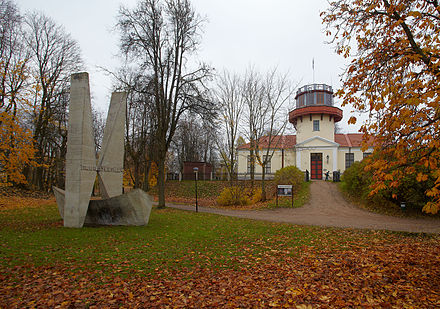 From Simuna, take road 124 to Rakke and Highway 22. The signs will already read Tartu, and the route goes along highways 22, 39 and 3.
From Simuna, take road 124 to Rakke and Highway 22. The signs will already read Tartu, and the route goes along highways 22, 39 and 3.
Take one of the local buses to one of the railway stations on the Tallinn-Tartu line, and then the train to Tartu.
- ["Dorpat": Tartu Observatory, Tartu](https://www.tahetorn.ut.ee/en)[ 📍](https://www.google.com/maps?ll=58.378789,26.720169&q=58.378789,26.720169&hl=en&t=m&z=11) - Tartu's old observatory is point number one on the Struve arc, and can be considered the heart of this itinerary. Tartu has been an university city for centuries and it was here that the astronomer lived and worked and directed the triangulation survey. The old observatory has an astronomy exhibition and free public observation nights take place here.
Latvia
Take out your map or GPS navigator and be prepared to drive longer sections on unpaved (sometimes narrow) roads through woods and fields with little road signs.
From Tartu, drive along Highway 3 to the twin city of Valga/Valka bisected by the Estonian-Latvian border, and P24 onwards to Smiltene. From Smiltene, continue along P27 towards Gulbene. In the hamlet of Ķeņģi about 16 km along the road, turn right to Jaunpiebalga, and from there P33 towards Vecpiebalga and on to Ērgļi. From Ērgļi, take P79 towards Irši, and the marker is about 8 km south along this road.
Continue to Valga by bus or train, from there take another train (or bus) towards Riga. It's a divided city with the railway station on the Estonian side; if you wish to continue by bus you need to cross into Valka. The next point is again somewhat hard to access without a car, to skip it continue all the way to Riga, otherwise get off in Cēsis. There's one daily bus leaving early in the morning from Cēsis going down to Ērgļi and all the way to Jēkabpils and Daugavpils. From Ērgļi, two local buses a day take you to the Barkaizi bus stop, not far from the Sestukalns point. Alternatively you can walk from Ergli, the point is some 7 km south of the city.

- ["Sestu-kalns": Ziestu, Sausneja, Region of Madona](https://www.ergli.lv/public/eng/tourism_relaxation/sightseeing/)[ 📍](https://www.google.com/maps?ll=56.84,25.636667&q=56.84,25.636667&hl=en&t=m&z=11) - The Sestukalns marker is again a bit off built-up areas but not that difficult to access if you have a car. It is about 100 m from the P79 road into the forest, the hill (216.5 m ASL) is nowadays called Ziestu.
To get straight to the next world heritage-listed point, continue to Irši and by an unnumbered road east to P78 which takes you south to Pļaviņas. From there highway A6 to Jēkabpils, following river Daugava.
Alternatively, now is your chance to visit a country high point. Backtrack to Ērgļi, take P78 southeast for a short distance from there, then P81 towards Madona. In the village of Vestiena, road signs show the way to Gaiziņkalns, at 312 m ASL the highest hill in Latvia. The hill was used by Struve's team for triangulation and there's also a marker here (although not part of the world heritage site). From Gaiziņkalns, continue along the same unnumbered road to Bērzaune, by P37 to Pļaviņas and A6 to Jekabpils.
From Ērgļi, catch the same bus you traveled on from Cēsis to get to Jēkabpils. If you've started this leg in Riga (skipped the last point), you can get to Jēkabpils by bus or to Krustpils on the other side of Daugava by train. In the latter case, there's a 5 km walk to get from Krustpils railway station to the point.
- ["Jacobstadt": Jekabpils, Region Jekabpils](https://jekabpilsrezidence.lv/struve-park/)[ 📍](https://www.google.com/maps?ll=56.501389,25.856667&q=56.501389,25.856667&hl=en&t=m&z=11) - This marker, unlike the former, is in an urban environment (and one of those easily accessible without a car), in a park nowadays named Struves Parks bordering Daugava.
Lithuania
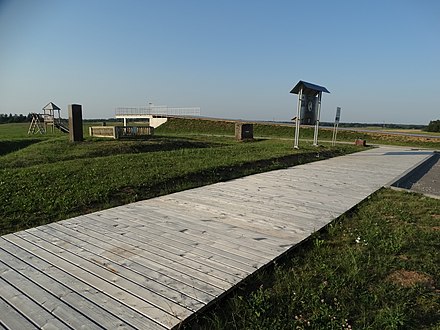
Looking at a map, it would seem logical to travel to Daugavpils and towards the Lithuanian points from there. However, public transport across the border from Daugavpils and in northeastern Lithuania are surprisingly scarce. Therefore it's easiest to head up to Riga, take a bus towards Lithuania as far as Panevėžys (stay on the bus to Vilnius if you wish to skip the two next points). Continues by bus or train (one each daily) towards Rokiškis until Panemunėlis. The point is next to the highway and the nearest bus stop, Baltakarčiai, is less than 1 km from the point, whereas there's about 4.5 km of walking from Panemunėlis railway station.
- ["Karischki": Gireišiai, Panemunelis, Northern Lithuania](https://www.rokiskiotic.lt/en/struve-geodetic-arc-gireisiai-point-area)[ 📍](https://www.google.com/maps?ll=55.9025,25.436667&q=55.9025,25.436667&hl=en&t=m&z=11) - Right next to the road between Rokiškis and Kupiškis, the place is more visible than other rural points as there's a fence around the marker, and elevated viewpoint to have a look around the fields, a little playground and a big parking area.
Continue for a few kilometers further along the road, then turn to a smaller road going south to Kamajai. From there, road 120 southwest to Svėdasai, then road 118 southeast to Utena. Then, the trip continues for almost 70 km along a major road, highway A14 towards Vilnius. Turn west towards Paberžė - the marker is signposted from the main highway.
To continue, you may be in for a walk of around 10 km to Rokiškis. From there, there are a couple of daily buses to Vilnius, and the following point is near the highway. Nevertheless, make sure that the bus stops at the Naujasėdžiai bus stop near the point, apparently buses from as far as Rokiškis skip stops closer to Vilnius. Otherwise you should change buses along the road, for instance in Molėtai. Once off the bus, the point is about 1 km off the highway towards Meškonys and into the woods.
- ["Meschkanzi": Meškonys, Nemencine, Eastern Lithuania](https://exploretrakaivilnius.lt/en/manors-and-parks/struve-geodesic-arch-points-in-meskonys-and-paliepiukai)[ 📍](https://www.google.com/maps?ll=54.930833,25.31666&q=54.930833,25.31666&hl=en&t=m&z=11) - This marker is in the hamlet of Meškonys, there's a small parking pocket next to the road and from there a path goes for 200 m slightly uphill through the meadow to the marker.
Continue along the highway to the Lithuanian capital Vilnius, whose old town is on the world heritage list. A few kilometers after leaving the marker you will pass another monument next to the highway marking the center of Europe (according to one calculation).
If you're collecting world heritage sites, and want one more, don't head straight to Vilnius but turn right to Maišiagala along road 108 and on to Dūkštos and from there towards Kernavė along road 116. Kernavė is an archaeological site and the former capital of Lithuania and features pre-Christian grave mounds. Backtrack to Dūkštos, continue in the same direction via Sudervė, Avižieniai and highway A2 to get to Vilnius.
From Vilnius, head east towards the Belarusian border along Highway A3. When the exit says Naujoji Vilnia, get off the highway and drive northeast passing under the highway. Immediately turn right towards Rukainiai and drive parallel to the highway for 1.5 km or so, then there's a sign guiding you to turn left to get to the next Struve point along gravel roads.
Walk back to the highway and take a bus to Vilnius. The following point is in the eastern outskirts of the Lithuanian capital and is accessible by city bus. Bus 14 takes you to 1-asis Didžiasalis, from the bus stop you should walk east for about 2 km to the hamlet of Paliepiukai where the point is.
- ["Beresnäki": Paliepiukai, Nemežis, Eastern Lithuania](https://exploretrakaivilnius.lt/en/manors-and-parks/struve-geodesic-arch-points-in-meskonys-and-paliepiukai)[ 📍](https://www.google.com/maps?ll=54.634444,25.429167&q=54.634444,25.429167&hl=en&t=m&z=11) - This marker sits in the middle of a field just outside Vilnius. This point is fairly simple, an information sign and a bench, but on the upside you can get right next to it by car.
The marker in Paliepiukai is the last one in the Baltic States, and indeed the European Union and Schengen area. To cross into Belarus most nationalities will need a visa and a green card for your car - see our Belarus article for details. Somewhat less bureaucracy is needed to enter Ukraine and Moldova (e.g. western nationalities can generally enter visa-free), so if you want to avoid that you could head west to Marijampolė and Poland, drive via Białystok and Lublin and then turn east to enter Ukraine. Nevertheless if you have your papers in order, get back on the highway and head for the Belarusian border, which isn't that far away. If you want to visit another country high point, this is possible through a short side trip: turn right towards Mednininkai just before the border and drive past the village. Follow the signs to Juozapinės kalnas, to get to Aukštojas, at 294 m ASL the highest point in Lithuania.
Belarus
From now on be prepared for a different driving experience, much of the rest of the itinerary will take you along rural side roads in comparatively poor countries. The fun doesn't end there; place names in Belarus are often transcribed to Latin letters in more than one way, and may have Russian name with usually with a few vowels and "s" sounds changed which also may be transcribed in different ways.
.jpg/440px-%D0%A6%D1%8E%D0%BF%D1%96%D1%88%D0%BA%D1%96._%D0%94%D1%83%D0%B3%D0%B0_%D0%A1%D1%82%D1%80%D1%83%D0%B2%D1%8D._%D0%9F%D1%83%D0%BD%D0%BA%D1%82_%C2%AB%D0%A2%D1%83%D0%BF%D1%96%D1%88%D0%BA%D1%96%C2%BB_(01).jpg) After crossing the border, continue towards Minsk (Мінск) along M7. At the town of Kreva (Крэва), get off the highway and drive west along P95. After some 14 km on the road, turn right towards the hamlet of Ciupiški (Цюпішкі).
After crossing the border, continue towards Minsk (Мінск) along M7. At the town of Kreva (Крэва), get off the highway and drive west along P95. After some 14 km on the road, turn right towards the hamlet of Ciupiški (Цюпішкі).
To get into Belarus, take train from Vilnius towards Minsk. The first point is another one that takes some effort to access by public transit. One option would be taking the train to Smargon (Смаргонь), and from there a bus (there are two daily, leaving early and late in the morning) towards Grodno (Гродна). These go via Halshany (Гальшаны) and stop at the junction to Tyupiski (Цюпішкі) too from where there is about 2 km to the point. If you travel by bus to Minsk, the highway passes Ashmanyany (Ашмяны), from where there might be buses towards Halshany from where you need to walk a bit back towards Tyupiski. To skip this point, remain on the train until Molodechno (Маладзечна) and change to a train going towards Grodno (Гродна).
- ["Tupischki": Tupishki, Oshmyany, Grodno Oblast](https://planetabelarus.by/sights/geodezicheskiy-punkt-dugi-struve-tyupishki/?sphrase_id=27871)[ 📍](https://www.google.com/maps?ll=54.291667,26.045278&q=54.291667,26.045278&hl=en&t=m&z=11) - About 500m southwest of the hamlet lies the marker; apparently at a height of 311 m ASL. It's marked by a small black obelisk with a globe representing the Earth on the top of it. Get back on the road and continue in the same direction to Haĺšany and on (the road is now numbered P48) to Iuye (Іўе). Take P5 south for a few kilometers to Highway M6, and continue west past Lida (Ліда, a somewhat bigger city) towards the regional capital of Grodno. At Vialikaje Mažejkava (Вялікае Мажэйкава), also known by the Russian name Bolshoe Mozheikovo, turn off the highway to the southeast and drive south to the town of Zhaludok (Жалудок). Continue west along P141 to Rozhanka (Ражанка) and after a little more than 10 km the Lopati marker is right next to the road, on the left-hand side.
Catch the next bus (or stay overnight in Halshany or take a taxi) to get to Lida. From there, continue towards Grodno (Гродна) by train - the same which you would travel on if having skipped the previous point - and travel to Rozanka (Ражанка). The Lopati point is about 6 km east of Rozanka railway station.
- "Lopati": Lopaty, Zelva, Grodno Oblast 📍 - The Lopati marker is easily accessible in the middle of a field right next to the P141 road. After Lopaty, turn back and drive east along the P141 to Belitsa (Беліца). Just before the town, turn to the M11 and drive south past Dziatlava (Дзятлава) and Slonim (Слонім) to the southern end of the road, then Highway M1 southwest towards Brest (Брэст) for about 10 km. At Ivatsevitsy (Івацэвічы), turn southeast to the P6 and drive almost all the way to Pinsk (Пінск). Just after crossing Yaselda River, the road makes a sharp bend to the left, and there's a junction going straight ahead and another one immediately afterwards turning right - turn off here and drive northwest parallel to the river towards Motal (Моталь) for a little more than 20 km, just past the village of Moladava (Моладава) to get to the first of a set of three points quite close to each other.
Walk back to Rozhanka. From here you can board the Grodno-Gomel (Гомель) nighttrain, that has cars going to Brest (Брэст) (going back west from Luninets). Travel on that train to Pinsk (Пінск) (no, not Minsk), and from there there are a few daily local buses to Motal. Get off just before Motal (Моталь), in Molodovo (Моладава) or Osovnitsa (Асаўніца), as the point is between these villages, a few kilometers along paths off the road.
- "Ossownitza": Ossovnitsa, Ivanovo, Brest Oblast 📍 - The point is in a field, about 500 m south of the road between Moladava and Osovnitsa/Asaunitsa. Nevertheless the paths from the road zigzag back and forth so the distance is almost certainly longer. This is again a black pedestal with a black globe on top. Next to it there's a tripod with a "barrel" a few meters above ground.
Continue to Motal (Моталь), and turn south towards Ivanovo/Ivanava (Іванава). After about 13 km, turn right to a smaller road towards the hamlet of Shchekotsk (Шчакоцк), and after 100 m a road or path veers off to the right into the forest to the next marker.
 Some more walking is required to get to the next point; 3 km to Motol (Моталь) and another 13 km south towards Ivanovo (Іванава) and a few hundred meters into the forest to get to Chekutsk (Шчакоцк). As there will be even more walking from there before public transportation is available, this is another point people who aren't fans of that may want to skip it. To get directly to the next point, return to Pinsk by bus, and continue west by train to Yanov-Polesski (Янов-Полесский), the station serving Ivanovo.
Some more walking is required to get to the next point; 3 km to Motol (Моталь) and another 13 km south towards Ivanovo (Іванава) and a few hundred meters into the forest to get to Chekutsk (Шчакоцк). As there will be even more walking from there before public transportation is available, this is another point people who aren't fans of that may want to skip it. To get directly to the next point, return to Pinsk by bus, and continue west by train to Yanov-Polesski (Янов-Полесский), the station serving Ivanovo. - "Tchekutsk": Chekutsk, Ivanovo, Brest Oblast 📍 - Similar in design to the other two points in the region, this marker is in the middle of a pine forest a few hundred meters from the Motal-Ivanava road. Continue towards Ivanava (Іванава), and when you come to the last town before Ivanava, Lyaskovichi (Ляскавічы), turn left at the Pereluok Yubileynii (переулок Юбилейный, "Jubileum street"), the 6th street on the left and drive it to the end. The street will first have one-family homes at both sides, then it will change name to Ulitsa Beryozovaya (улица Берёзовая) and there will be houses on the left and forest on the right. The street will end at a field or meadow, with another street or path going to the left. The marker is in that field, more or less straight ahead.
It's 5.5 km to the town of Lyaskovichi, more exactly to the junction of Pereluok Yubileynii (переулок Юбилейный, "Jubileum street") which you should walk east for 1.5 km to the end to get to the next point, which is in the middle of a field.
If you've stepped off the train in Yanov-Polesski (Янов-Полесский), cross over the railway to Ulitsa Chapayeva (вуліца Чапаева), walk it one block to the east and head north on Polevaya Ulitsa (Палявая вуліца) past some industrial plants. After these, turn right and walk Ulitsa Gagarina (улица Гагарина) to its end, turn right again and walk Ulitsa Sovietskaya (улица Советская) to the M10 highway. Cross it and walk along the path with the field on your right side (forest on your left), after a while there's another path veering off right leading to the marker.
- "Leskowitschi": Leskovichi, Ivanovo, Brest Oblast 📍 - In a field, reportedly it's good to rubber boots when walking here to avoid getting your feet wet. It's again a black marker and a barrel on a tripod. Get back to the main road, and continue south to Ivanava (Іванава), and get on P144 south towards Rudsk (Рудск) and the village of Kalena (Калена) and through the Mokhro (Мохро)-Dolsk (Дольськ) border crossing into Ukraine.
From the Leskovichi marker, head down to the Yanov-Polesski railway station like in the description above but in the opposite order.
Ukraine and Moldova
After the border, the road will get the Ukrainian number P14. Keep going all the way to Lutsk (Луцьк), with more than 200,000 inhabitants the biggest city on this itinerary since Vilnius. From there, take Highway M19 to Dubno (Дубно) and on to another relatively big city, Ternopil (Тернопіль) (no, not Chernobyl - that's a few hundred kilometers northeast ). From Ternopil, turn east along Highway M12 E50 and drive almost to the next large city, Khmelnytskyi (Хмельницький). About 20 km before, turn north on a smaller road numbered T2302 (though may not be signposted as such) towards Vodychky (Водички). Drive along that road for about 20 km to the twin towns of Maryanivka (Мар'янівка) and Chornyi Ostriv (Чорний Острів) bisected by a railway, and continue north towards Antonivka (Антонівка). Just outside town, take the road that forks off left to the hamlet of Katerinovka (Катеринівка), drive past the hamlet and the point is in the field to the right at some distance from the road.
Take a train to Brest (Брэст). As there does not seem to be any train services into Ukraine, you need to take the bus to Kovel (Ковель). From there, ride the train to Kiev (Київ) until Rovno/Rivne (Рівне) or Shepetivka (Шепетівка) and take a bus to Khmelnytskyi (Хмельницький). This city can serve as a base for exploring three points around it - each of which will entail long walks. To get to the Katerinovka point, take a local train northwest to Chorni Ostriv (Чорний Острів). From the station, walk north halfway to Antonivka (Антонівка), then take the road left to Katerinovka (Катеринівка), walk past the hamlet and the marker is on the right-hand side, about 11 km from the station. Then, backtrack to Chorni Ostriv and Khmelnytskyi.

- "Katerinowka": Katerinowka, Antonivka, Khmelnytskiy region 📍 - The Katerinowka marker is about 500 m northwest of the rural road north of Katerinovka. There is a straight path from the road to the point, which is made up of a black stone a bit reminiscent of a gravestone with an inscription in Ukrainian describing Struve's measurement project. Next to it there's a tripod with a small disk on the middle rod. The last points in Belarus were a set of three close to each other, and the first ones in Ukraine is also a set of three fairly close to each other (though not as close as the Belarusian ones). Backtrack to the M12, drive back 1 km towards Ternopil (Тернопіль) and turn south towards Gvardyiske (Гвардійське). Past that small town, the following point is near the road.
There are (not that frequent) local buses from Khmelnytskyi driving a circular route to Yarmolintsy (Ярмолинці), Gorodok (Городок), past the Felschtin point and back to Khmelnytskyi. Another option are buses west along the M-12 to the Klimkyvtsy (Климківці) bus stop among several gas stations. From there it's a 10 km walk down past Nemichintsy (Немичинці) and Gvardyyske (Гвардійське) to the marker.

- "Felschtin": Felschtin, Hvardiiske, Khmelnytskiy region 📍 - Like many other markers in the southern part of the world heritage, this one is also in a field on a little elevated point and is one of those where little hiking is required as it is almost next to the road. Again it is a black stone, a bit larger than the last one, has a tripod setup and a white Orthodox Christian cross next to it. Continue along the same road to the next bigger town, which is Gorodok (Городок). For a sidetrip to another world heritage site, drive west along P50 to Sataniv (Сатанів), and from there P48 south for some 15 km, after which you should turn west to Ivankivtsi (Іванківці). Just south of that village is the Satankivski botanical garden, listed under the name Satanivska Dacha as one of the components of the Beech forests of Europe site. After this natural visit, drive back to Gorodok (Городок). From Gorodok, take P50 east to Yarmolitsi (Ярмолинці), and from there road H03 towards Khmelnytskyi. Just after Yarmolitsi, turn right on a smaller road to the village of Sutkivtsi (Сутківці). Continue along the same road to the village of Baranivka (Баранівка), the point is on the left side of the road just before that village.
From Khmelnytskyi there are local buses to the hamlet of Baranovka (Баранівка) right next to the point; but apparently there are no buses in the other direction - they continue to Krutye Brody (Круті Броди) and from there somewhere without passengers. From the point, there's about 12 km back to the Khmelnytskyi-Yarmolintsy highway, and if you can't flag down a bus back to Khmelnytskyi there, another 3 km to central Yarmolintsy.
- "Baranowka": Baranowka, Baranivka, Khmelnytskiy region 📍 - About 100 m off the road in a field surrounded by some trees, this is a simpler marker comprising a black stone with inscription in Ukrainian. The itinerary will again go along smaller roads for quite some distance. Past Baranivka (Баранівка), in the same direction, the road gets a bit narrower and zig-zags south through the fields, eventually connecting to T2315 (probably unnumbered on signs) between Solobkivtsi (Солобківці) and Zinkiv (Зіньків), head east to the latter, and on to Vinkivtsi (Віньківці). From there, continue east along T2305 to Yaltushkiv (Ялтушків), T0610 to Bar (Бар) and just before that town, turn to T0229 southeast eventually taking you to M21 E583 heading south to Mohyliv-Podilsky (Могилів-Подільський), where the Dnestr river is crossed into Otaci in Moldova. From Otaci, drive along R9 towards Soroca. Some 20 km along that road, the road passes near the village of Rudi with the only point in Moldova on the right hand side of the road.
Moving on from the region around Khmelnytskyi, you can take a train or bus to Vinnytsya (Вінниця), and from there a bus to Mogliv-Podilsky (Могилів-Подільський) on the Dnestr river. Cross the border to Otaci in Moldova and take a bus towards Soroca. It will stop at Rudi, if the bus stops at the junction from the highway that'll be right next to the point, if in the village, you need to walk 2.5 km to the point.
- "Rudy": Rudi, Soroca Judetul 📍 - The marker is near the Otaci-Soroca highway. A smaller road leads off the highway and then there's a path to the white pedestal with a while globe on the top of it, a marker stone in the ground, and an information sign.
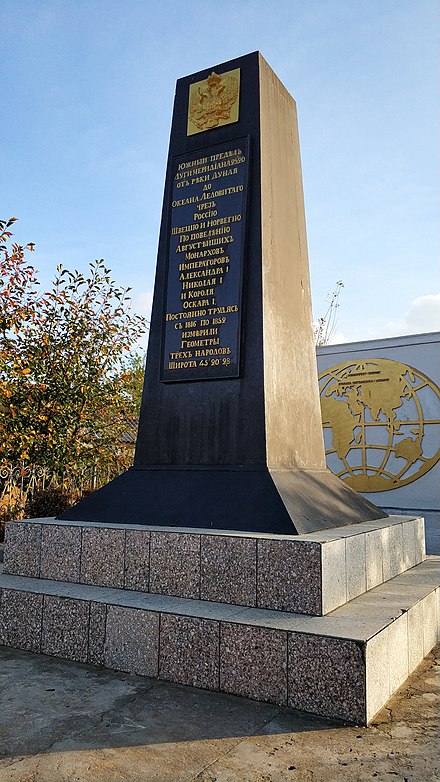 The highway continues to Soroca, from there take Highway M2 down to Orhei and the capital Chisinau. From there, follow Highway M3 via Comrat and further south. Just before the town of Vulcănești, the road will pass right next to a border crossing back into Ukraine. Turn left, cross the border and drive a short distance to the next town, Bolhrad. From there, south to Izmail (Ізмаїл) at the Danube Delta. A few kilometers to the east is the small town of Stara Nekrasivka (Стара Некрасівка), with the final point in this itinerary.
The highway continues to Soroca, from there take Highway M2 down to Orhei and the capital Chisinau. From there, follow Highway M3 via Comrat and further south. Just before the town of Vulcănești, the road will pass right next to a border crossing back into Ukraine. Turn left, cross the border and drive a short distance to the next town, Bolhrad. From there, south to Izmail (Ізмаїл) at the Danube Delta. A few kilometers to the east is the small town of Stara Nekrasivka (Стара Некрасівка), with the final point in this itinerary.
Continue by bus to Soroca, and on to Chisinau where you probably will arrive at the northern bus station. The southern bus station where buses to Izmail depart from is southeast of the city, some 6.5 km from the northern station. There are city buses going there, if you're not in the mood for a walk, that is. From Chisinau, the bus goes to the south of the country, crosses back into Ukraine and to Izmail (Ізмаїл). From Izmail bus station, there may be local buses to Staro Nekrasivka, other than that it's a 7.5 km walk. Walk east along Pushkina Vulitsya (Пушкіна вулиця) until it ends at a church, walk one block south and then turn left to continue east along Lysova Vulitsya (Лісна вулиця). That street turns into a straight road leading out of Izmail, across a field and into the town of Stara Nekrasivka (Стара Некрасівка) becoming its main street. Almost through the town, turn right at Lenina Vulitsya (Ленина Вулиця) and walk one block south. There it is; the southernmost point.
- "Staro-nekrassowka": Stara Nekrasivka, Nekrasivka, Odessa region 📍 - This point is unusually set among single-family homes in the southeast of the town, south of the main road. It's the grandest of the rather modest Ukrainan markers and made up of a black obelisk with inscriptions including the Russian imperial eagle on the top. It's right at the corner of Lenina Vulitsya (Ленина Вулиця) and Poshtova Vulitsya (Поштова вулиця) so no hiking is required.
For where to head next you have more option in this end of the arc than in the top of Europe. The same goes if you're doing the trip in reverse, starting from the south. To get in to Stara Nekrasivka from Northern, Western or Central Europe, head towards Vienna, Budapest, Cluj-Napoca, Brasov and Galati. From further south, you could head towards Trieste, Zagreb, Novi Sad, Timisoara, Brasov and Galati. From the southern Balkans head towards Bucharest and to Galati. There's no road crossing from Romania to Ukraine, so you need to cross into Moldova from Galati and on to Ukraine, alternatively cross the Danube by ferry domestically, drive to Isaccea and take another ferry across to Ukraine. From eastern Europe, you could drive in via Kiev and Odessa.
Getting out (or in if you start here) from the southernmost point means getting back to Izmail. From there you can take a train to Odessa, or stay on the same train all the way to Kiev. Backtracking to Chisinau is another alternative. Romania is close by, you need to travel through Moldova to get there.
Stay safe
Consult the individual country articles for safety precautions.
Some of the points are hard to access and entail hiking uphill or through difficult terrain.
Go next
Stretching along most of Europe from north to south, there are several places worth visiting near the route of the arc.
If you are at the northern end of the Geodetic Arc, Nordkapp, the northernmost point in Europe reachable by car, isn't far away. Or you could explore Finnmark or travel the Norwegian coast with Hurtigruten.
In the southern end, you're already in the Danube Delta, the Black Sea metropoles of Odessa and Constanta are relatively nearby as is the great city of Bucharest. The other "end" of Europe (in a sense), is Istanbul, a few hundred kilometers south and on the way there you can explore coastal Bulgaria.
The Norrbotten Megasystem is an industrial cluster in northern Scandinavia, parallel to the geodetic arc.
<maplink text="" zoom="6" group="route1" class="no-icon"> { "type": "FeatureCollection", "features": [ { "type": "Feature", "properties": {}, "geometry": { "type": "LineString", "coordinates": [ [ 23.32878, 68.63728 ], [ 23.32474, 68.63797 ], [ 23.3201, 68.6377 ], [ 23.30080, 68.64039 ], [ 23.28938, 68.64421 ], [ 23.27539, 68.64505 ], [ 23.26732, 68.64721 ], [ 23.26380, 68.64649 ], [ 23.25016, 68.64802 ], [ 23.24591, 68.64715 ], [ 23.23441, 68.64815 ], [ 23.23200, 68.64949 ], [ 23.20891, 68.65410 ], [ 23.18617, 68.66500 ], [ 23.17952, 68.66514 ], [ 23.16535, 68.66898 ], [ 23.15608, 68.66734 ], [ 23.15407, 68.66459 ], [ 23.12531, 68.66561 ], [ 23.11012, 68.66647 ], [ 23.10321, 68.66814 ], [ 23.09420, 68.67159 ], [ 23.09420, 68.67268 ], [ 23.09094, 68.67354 ], [ 23.08399, 68.67382 ], [ 23.08244, 68.67318 ], [ 23.07815, 68.67372 ], [ 23.07399, 68.67650 ], [ 23.07437, 68.67833 ], [ 23.07296, 68.67933 ], [ 23.06940, 68.67995 ], [ 23.05433, 68.67343 ], [ 23.05528, 68.67694 ], [ 23.04953, 68.67839 ], [ 23.04622, 68.68015 ], [ 23.04305, 68.68056 ], [ 23.04090, 68.68048 ], [ 23.03751, 68.68118 ], [ 23.03794, 68.68014 ], [ 23.03987, 68.68510 ], [ 23.01107, 68.68852 ], [ 22.99850, 68.67817 ], [ 22.99631, 68.67182 ], [ 22.99901, 68.66896 ], [ 22.97026, 68.67544 ], [ 22.94164, 68.67894 ], [ 22.92215, 68.68585 ], [ 22.91323, 68.68001 ], [ 22.89593, 68.67942 ], [ 22.89018, 68.67861 ], [ 22.87611, 68.68293 ], [ 22.85834, 68.68391 ], [ 22.85387, 68.68407 ], [ 22.84971, 68.68209 ], [ 22.82787, 68.68546 ], [ 22.81843, 68.68791 ], [ 22.81062, 68.68797 ], [ 22.80105, 68.68925 ], [ 22.77440, 68.68717 ], [ 22.77534, 68.68292 ], [ 22.77367, 68.68270 ], [ 22.77337, 68.68271 ], [ 22.74547, 68.68294 ] ] } } ] } </maplink>Struve Geodetic Arc
Timezone:MultipleCoordinates:52.29, 25.65
